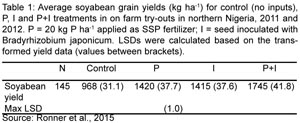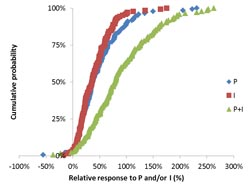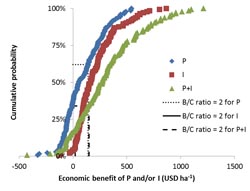In N2Africa we are reaching thousands of farmers in each country over the course of the project. Through collection of data among these farmers, we can get an impression of how well the legume technologies that we offer work in different areas, on different types of soils and for different types of farmers. With data from dissemination trials of farmers in Nigeria in phase I, collected by extension officers and dissemination partners (Sasakawa Global 2000, KADP, KNARDA, Federal University of Technology, Minna), we evaluated the results of widespread testing of promiscuous soyabean varieties in northern Nigeria. We were interested in the response of these varieties to SSP fertilizer and rhizobial inoculants under the wide diversity of farmers’ fields and management practices. We wanted to understand the effects of the different variables in the (GL x GR) x E x M relationship (where GL is the legume genotype, GR the rhizobium strain(s) nodulating the legume, E the biophysical environment and M the agronomic management) on soyabean yields and the response to input application. We also evaluated the consequences of variability in yield for the distribution of economic benefits of input application. Finally, we explored the ability to predict soyabean yields and response to inputs for targeting of technologies among a new group of farmers in different areas or new seasons. This study was recently published in Field Crops Research. Below the abstract of the paper with the most interesting results.
|
Soyabean yields could benefit from the use of improved varieties, phosphate-fertilizer and rhizobium inoculants. In this study we evaluated the results of widespread testing of promiscuous soyabean varieties with four treatments: no inputs (control); SSP fertilizer (P); inoculants (I) and SSP plus inoculants (P+I) among smallholder farmers in northern Nigeria in 2011 and 2012. We observed a strong response to both P and I, which significantly increased grain yields by 452 and 447 kg ha-1 respectively. The additive effect of P+I (777 kg ha-1) resulted in the best average yields (Table 1).
Variability in yield among farms was large, which had implications for the benefits for individual farmers (Figures 1A&B). Moreover, although the yield response to P and I was similar, I was more profitable due to its low cost (Figure 1C). Only 16% of the variability in control yields could be explained by plant establishment, days to first weeding, percentage sand and soil exchangeable magnesium. Between 42% and 61% of variability in response to P and/or I could be explained by variables including year, farm size, plant establishment, total rainfall and pH. The predictive value of these variables was limited, however, with cross-validation R2 decreasing to about 15% for the prediction between Local Government Areas and 10% between years. Implications for future research include our conclusion that averages of performance of technologies tell little about the adoption potential for individual farmers. We also conclude that a strong agronomic and economic case exists for the use of inoculants with promiscuous soyabean, requiring efforts to improve the availability of good quality inoculants in Africa. The full paper is accessible through: http://dx.doi.org/10.1016/j.fcr.2015.10.023. Esther Ronner
|
Figure 1. Cumulative probability of estimated absolute response (kg ha-1) (A); relative response (%) (B) and economic benefits (additional yield minus relevant input costs, US$ ha-1) (C) of P and/or I compared with control. Dashed lines in Fig. C represent a benefit/cost (B/C) ratio of 2 for the application of P and/or I. P = 20 kg P ha-1 applied as SSP fertilizer; I = seed inoculated with Bradyrhizobium japonicum. Source: adapted from Ronner et al., 2015. |




